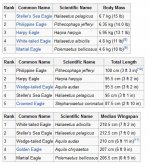Jeff, have you seen the Tasmanian Wedge-tailed Eagle?
(Aquila audax fleayi).
Like the Philippine Eagle, it also is Endangered, maybe critically so, with low breeding numbers / success, and less than 440 adults remaining in the wild.
It is subject to similar pressures (population, urbanisation, old growth forest logging, rural, and forestry practices, etc) ...... :-C
Ok, after a bit of searching through the material (mostly ~unreferenced - Wiki etc - [hard to tell whether some weights are normal maximums* or averages], nor peer reviewed), here's what numbers I could manage to dig up:
my list
(refers to weights = average for species, ie. includes both male and female) ....
1. Steller's Sea Eagle...........6.95kg (15.3lbs)
2. Harpy Eagle....................6.50kg (14.3lbs)
3. Philippine Eagle...............6.35kg (14.0lbs)
4. White-tailed Eagle............5.00kg (11.0lbs)
5. Bald Eagle.......................4.90kg (10.8lbs)
6. Golden Eagle...................4.65kg (10.2lbs)
7. Martial Eagle...................4.60kg (10.1lbs)
8. Wedge-tailed Eagle...........4.44kg (9.80lbs)
9. Verreaux's Eagle..............4.40kg (9.70lbs)
10.Crowned Eagle................3.63kg (8.00lbs)
Having said that, I think there are a number of points to consider:
(i) We are concerned with the "largest" = heaviest. Therefore since all eagles exhibit sexual dimorphism (where females are larger than males), I think it is perfectly reasonable to consider the average of female weights only.
(ii) Further, there are a number of species affected by
Bergmann's rule (ie. increasing size at larger latitudes = further away from the equator), particularly such as Golden Eagles, Wedge-tailed Eagles, and Bald Eagles (Alaska), as well as some others, so again, I think it is perfectly reasonable to consider the largest examples of females by geographic region.
(iii) In addition to this, some landscape /prey availability types, result in specialised even larger sub-species, such as the Golden Eagles of the broader Himalaya Region (Aquila chrysaetos daphanea.spp), and the Tasmanian Wedge-tailed Eagle (Aquila audax fleayi), so again, I think it is perfectly reasonable to consider this.
=>Those factors inform this next list then, but not including any captive records (as they may be great big fat over-fed birds), or heresay (even though I still think for Wedgies the maximum weights* [figures may have been averages, not range] recorded are underdone - there was a reference to one Tasmanian female of 2.84m wingspan, but no other weight, or length data):
largest eagles by average weight of females, and considering the above
1. Steller's Sea Eagle................................7.90kg (17.4lbs)
2. Harpy Eagle.........................................7.50kg (16.5lbs)
3. Philippine Eagle....................................6.50kg (14.3lbs)
4. Golden Eagle(c.dapahnea.spp)................6.35kg (14.0lbs)
5. Bald Eagle............................................6.20kg (13.6lbs)
6. White-tailed Eagle.................................5.75kg (12.7lbs)
7. Tasmanian Wedge-tailed Eagle(a.fleayi)...5.00kg (11.0lbs)+?
8. Martial Eagle.........................................4.70kg (10.3lbs)
9. Verreaux's Eagle...................................4.45kg (9.80lbs)
10.Crowned Eagle.....................................3.95kg (8.70lbs)
Chosun :gh:
Oh, and by the way boys,
THIS !! is the only reference I could find to the Thunderbird!
And the Thunderbird of the Americas had a wingspan of at least 12 feet.
Are you sure you don't mean wheelbase?
Bob










